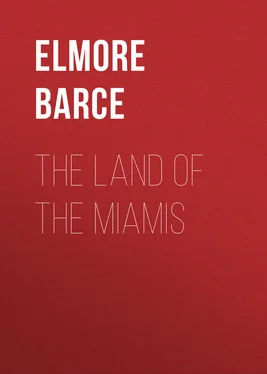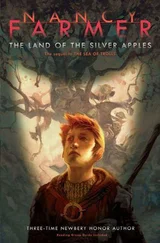Elmore Barce - The Land of the Miamis
Здесь есть возможность читать онлайн «Elmore Barce - The Land of the Miamis» — ознакомительный отрывок электронной книги совершенно бесплатно, а после прочтения отрывка купить полную версию. В некоторых случаях можно слушать аудио, скачать через торрент в формате fb2 и присутствует краткое содержание. ISBN: , Жанр: foreign_antique, foreign_prose, Историческая проза, на английском языке. Описание произведения, (предисловие) а так же отзывы посетителей доступны на портале библиотеки ЛибКат.
- Название:The Land of the Miamis
- Автор:
- Жанр:
- Год:неизвестен
- ISBN:http://www.gutenberg.org/ebooks/30244
- Рейтинг книги:4 / 5. Голосов: 1
-
Избранное:Добавить в избранное
- Отзывы:
-
Ваша оценка:
- 80
- 1
- 2
- 3
- 4
- 5
The Land of the Miamis: краткое содержание, описание и аннотация
Предлагаем к чтению аннотацию, описание, краткое содержание или предисловие (зависит от того, что написал сам автор книги «The Land of the Miamis»). Если вы не нашли необходимую информацию о книге — напишите в комментариях, мы постараемся отыскать её.
The Land of the Miamis — читать онлайн ознакомительный отрывок
Ниже представлен текст книги, разбитый по страницам. Система сохранения места последней прочитанной страницы, позволяет с удобством читать онлайн бесплатно книгу «The Land of the Miamis», без необходимости каждый раз заново искать на чём Вы остановились. Поставьте закладку, и сможете в любой момент перейти на страницу, на которой закончили чтение.
Интервал:
Закладка:
Let there be no mistaken glamour cast about this scene. Already the disintegration of the Indian power was setting in. The traders among them, both English and French, seem to have been a depraved, drunken crew, trying to get all they could "by foul play or otherwise," and traducing each other's goods by the circulation of evil reports. Hay says, "I cannot term it in a better manner than calling it a rascally scrambling trade." Winter came on and the leading chiefs and their followers went into the woods to kill game. They had nothing in reserve to live upon, and in a hard season their women and children would have suffered. The French residents here seem to have been a gay, rollicking set, playing flutes and fiddles, dancing and playing cards, and generally going home drunk from every social gathering. The few English among them were no better, and we have the edifying spectacle of one giving away his daughter to another over a bottle of rum. The mightiest chieftains, including Le Gris, did not scruple to beg for whiskey, and parties of warriors were arriving from the Ohio river and Kentucky, with the scalps of white men dangling at their belts.
There was still a considerable activity at this place, however, in the fur trade, and the English thought it well worth holding. Raccoon, deer, bear, beaver, and otter skins were being brought in, although the season was not favorable during which Hay sojourned there on account of it being an open winter. Constant communication was kept up with Detroit on the one hand and the Petit Piconne (Tippecanoe) and Ouiatenon on the other. La Fountaine, Antoine LaSalle, and other famous French traders of that day were doing a thriving business in the lower Indian country.
That these Miami villages were also of great strategical value from the military standpoint, and that this fact was well known to President Washington, has already been mentioned. The French early established themselves there, and later the English, and when the Americans after the Revolution took dominion over the northwest and found it necessary to conquer the tribes of the Wabash and their allies, one of the first moves of the United States government was to attack the villages at this place, break up the line of their communication with the British at Detroit, and overawe the Miamis by the establishment of a strong military post.
To the last, the Miamis clung to their old carrying place. Wayne insisted at the peace with the Miamis and their allies, at Greenville, Ohio, in 1795, that a tract six miles square around the newly established post at Fort Wayne should be ceded to the United States, together with "one piece two miles square on the Wabash river, at the end of the portage from the Miami of the Lake (Maumee), and about eight miles westward from Fort Wayne." This proposal was stoutly resisted by the Little Turtle, who among other things said: "The next place you pointed to, was the Little River, and you said you wanted two miles square at that place. This is a request that our fathers, the French or British, never made of us; it was always ours. This carrying place has heretofore proved, in a great degree, the subsistence of your younger brothers. That place has brought to us in the course of one day, the amount of one hundred dollars. Let us both own this place and enjoy in common the advantage it affords." Despite this argument, however, Wayne prevailed, and the control of Kekionga and the portage passed to the Federal government; that ancient Kekionga described by Little Turtle as "the Miami village, that glorious gate, which your younger brothers had the happiness to own, and through which all the good words of our chiefs had to pass from the north to the south, and from the east to the west."
Returning to the Potawatomi, it will be seen that this tribe, which originally came from the neighborhood of Green Bay, was probably from about the middle of the eighteenth century, in possession of most of the country from the Milwaukee river in Wisconsin, around the south shore of Lake Michigan, to Grand River, "extending southward over a large part of northern Illinois, east across Michigan to Lake Erie, and south in Indiana to the Wabash." The Sun, or Keesass, a Potawatomi of the Wabash, said at the treaty of Greenville, that his tribe was composed of three divisions; that of the river Huron, in Michigan, that of the St. Joseph of Lake Michigan, and the bands of the Wabash. In the year 1765, George Croghan, Indian agent of the British government, found the Potawatomi in villages on the north side of the Wabash at Ouiatenon, with a Kickapoo village in close proximity, while the Weas had a village on the south side of the river. This would indicate that the Potawatomi had already pushed the Miami tribe south of the Wabash at this place and had taken possession of the country.
Far away to the north and on both shores of Lake Superior, dwelt the Chippewas or Ojibways, famed for their physical strength and prowess and living in their conical wigwams, with poles stuck in the ground in a circle and covered over with birch bark and grass mats. The Jesuit Fathers early found them in possession of the Sault Ste. Marie, and when General Wayne at the treaty of Greenville, reserved the post of Michillimacinac, and certain lands on the main between Lake Michigan and Lake Huron, Mash-i-pinash-i-wish, one of the principal Chippewa chieftains, voluntarily made the United States a present of the Island De Bois Blanc, at the eastern entrance of the straits of Mackinac, for their use and accommodation, and was highly complimented by the general for his generous gift. A reference to the maps of Thomas G. Bradford, of 1838, shows the whole upper peninsular of Michigan in the possession of the Chippewas, as well as the whole southern and western shores of Lake Superior, and a large portion of northern Wisconsin. One of their principal sources of food supply was wild rice, and the presence of this cereal, together with the plentiful supply of fish, probably accounts for their numbers and strength. In the beginning of the eighteenth century, they expelled the Foxes from northern Wisconsin, and later drove the fierce fighting Sioux beyond the Mississippi. They were the undisputed masters of a very extensive domain and held it with a strong and powerful hand. One of their chiefs proudly said to Wayne: "Your brothers' present, of the three fires, are gratified in seeing and hearing you; those who are at home will not experience that pleasure, until you come and live among us; you will then learn our title to that land." Though far removed from the theatre of the wars of the northwest, they, together with the Ottawas, early came under the British influence, and resisted the efforts of the United States to subdue the Miamis and their confederate tribes, fighting with the allies against General Harmar at the Miami towns, against St. Clair on the headwaters of the Wabash and against Anthony Wayne at Fallen Timbers on the 20th of August, 1794.
The rudest of all the tribes of the northwest were the Ottawas, those expert canoemen of the Great Lakes, known to the French as the "traders," because they carried on a large trade and commerce between the other tribes. They seem to have had their original home on Mantoulin Island, in Lake Huron, and on the north and south shores of the Georgian Bay. Driven by terror of the Iroquois to the region west of Lake Michigan, they later returned to the vicinity of L'Arbe Croche, near the lower end of Lake Michigan, and from thence spread out in all directions. Consulting Bradford's map of 1838 again, the Ottawas are found in the whole northern end of the lower Michigan peninsula. Ottawa county, at the mouth of Grand river, would seem to indicate that at one time, their towns must have existed in that vicinity, and in fact their possessions are said to have extended as far down the eastern shore of Lake Michigan as the St. Joseph. To the south and east of these points "their villages alternated with those of their old allies, the Hurons, now called Wyandots, along the shore of Lake Erie from Detroit to the vicinity of Beaver creek, in Pennsylvania." They were parties with the Wyandots and Delawares and other tribes to the treaty of Fort Harmar, Ohio, at the mouth of Muskingum, in 1789, whereby the Wyandots ceded large tracts of land in the southern part of that state to the United States government, and were granted in turn the possession and occupancy of certain lands to the south of Lake Erie. The Ottawa title to any land in southern Ohio, however, is exceedingly doubtful, and they were probably admitted as parties to the above treaty in deference to their acknowledged overlords, the Wyandots. Their long intercourse with the latter tribe, in the present state of Ohio, who were probably the most chivalrous, brave and intelligent of all the tribes, seems to have softened their manners and rendered them less ferocious than formerly. Like the Chippewas, their warriors were of fine physical mould, and Colonel William Stanley Hatch, an early historian of Ohio, in writing of the Shawnees, embraces the following reference to the Ottawas: "As I knew them, (i. e., the Shawnees), they were truly noble specimens of their race, universally of fine athletic forms, and light complexioned, none more so, and none appeared their equal, unless it was their tribal relatives, the Ottawas, who adjoined them. The warriors of these tribes were the finest looking Indians I ever saw, and were truly noble specimens of the human family." The leading warriors and chieftains of their tribe, however, were great lovers of strong liquor, and Pontiac, the greatest of all the Ottawas, was assassinated shortly after a drunken carousal, and while he was singing the grand medicine songs of his race.
Читать дальшеИнтервал:
Закладка:
Похожие книги на «The Land of the Miamis»
Представляем Вашему вниманию похожие книги на «The Land of the Miamis» списком для выбора. Мы отобрали схожую по названию и смыслу литературу в надежде предоставить читателям больше вариантов отыскать новые, интересные, ещё непрочитанные произведения.
Обсуждение, отзывы о книге «The Land of the Miamis» и просто собственные мнения читателей. Оставьте ваши комментарии, напишите, что Вы думаете о произведении, его смысле или главных героях. Укажите что конкретно понравилось, а что нет, и почему Вы так считаете.












